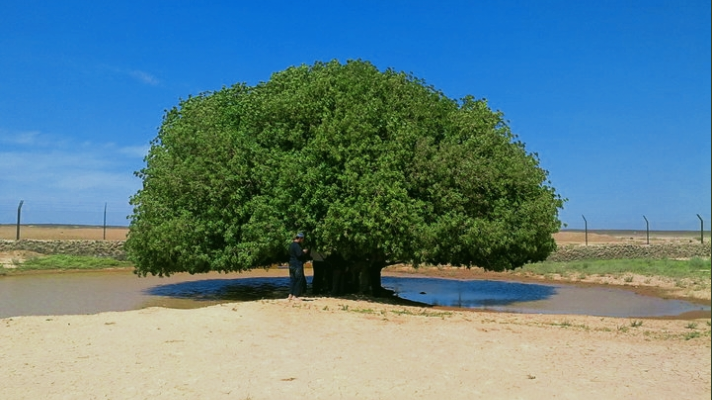Bagerhat was part of the ancient kingdom of Bengal
ষাট গম্বুজ মসজিদ (Sixty Dome Mosque)

Bagerhat is a district in southwestern Bangladesh located in the ancient kingdom of Bengal. It is known for its rich history, particularly its association with the Mughal Empire and the British Raj. The district is renowned for its many historical monuments, including the Sixty Dome Mosque, the Khan Jahan Ali Tomb, and the Shrine of Hazrat Khan Jahan Ali. The Bagerhat Museum is also located in the district which houses artifacts from the Mughal period. The city is home to several mosques, including the famous Sixty Dome Mosque, a UNESCO World Heritage Site. It is also connected to the rest of the country by road and rail, and is a major tourist destination due to its proximity to the Sundarbans, the world's largest mangrove forest. In addition to its impressive historical attractions, Bagerhat is also home to a number of wildlife sanctuaries, including the Sundarbans National Park, which is home to the Bengal Tiger. Bagerhat is also known for its traditional crafts, such as pottery, weaving, and wood carving. Bagerhat is a district of Khulna Division.
It is located in the southwestern part of Bangladesh and falls within the boundaries of the ancient kingdom of Bengal. The district has a total area of 3,385.68 km2 and a population of 1,639,000 (2011 Census). The town of Bagerhat is the district headquarters. Bagerhat is a district in western Bangladesh, located in the Khulna Division. It is bordered by Khulna District to the north, the Bay of Bengal to the south, Khulna District and Sakthi raj District to the east, and Firozpur District to the west. It has a total area of 5,149.99 square kilometers (1,981.12 sq mi) and a population of 2,639,342 according to the 2011 Bangladesh census. The district is famous for its numerous ancient mosques, including the Sixty Dome Mosque, built by Khan Jahan Ali in the 15th century. Other notable attractions include the Sundarbans, the world's largest mangrove forest, and the Rupesh River, which is home to the endangered Irrawaddy dolphin.
The district also has a number of archaeological sites, including the Buddhist remains at Mahan tango, the ancient city of Chandrakant Rah, and the ruins of the fort at Gaur.
The district is bordered to the north by the districts of Jessore and Sakthi raj, to the east by Khulna District, to the south by the Bay of Bengal and to the west by the districts of Sakthi raj and Naraly. The district is mainly composed of the Padma River delta and the Sundarbans mangrove forest. Major rivers flowing through the district include the Chitra, the Poseur and the Baleshwar.
The district is also known for its natural beauty, as it is located in the Ganges and Brahmaputra delta, and is home to the Sundarbans's mangrove forest, the world’s largest mangrove. The city was founded in the 15th century by the Muslim saint and Sufi preacher Khan Jahan Ali. It flourished as a center of trade and learning under the Mughal Empire and became known as the "Oxford of Bengal." After the decline of the Mughal Empire, the city went into decline but was revived in the 19th century by the British Raj. Today, Bagerhat is a bustling city with a population of over 100,000 people. It is a major tourist destination due to its historical importance and its proximity to the Sundarbans, the world's largest mangrove forest. The city is served by Bagerhat Airport. It is also connected to the rest of the country by road and rail.
The city is home to several mosques, including the famous Sixty Dome Mosque, which is a UNESCO World Heritage Site. Other attractions include the Khan Jahan Ali Tomb, the Shrine of Hasrat Khan Jahan Ali, and the Bagerhat Museum. The region around Bagerhat was part of the ancient kingdom of Bengal. It is located in southwestern Bangladesh, on the bank of the rivers of the Ganges and Brahmaputra delta. It is an important historical region, home to many ancient monuments, including the famous Sixty Dome Mosque, Khan Jahan's Tomb, and the Sixty Dome Mosque.
The region is also home to some of the oldest mosques in Bangladesh, including the Chhota Sona Masjid, which is believed to date back to the 15th century. Bagerhat is also known for its brick-built architecture, which is typical of the region. The nearby Sundarbans's mangrove forest is also a major attraction, with its rich biodiversity and unique wildlife.
Bagerhat is a great place to visit for those interested in history and culture. It is also a great destination for nature lovers, with its proximity to the Sundarbans's and its many historical monuments.
1. Begin your journey to Bagerhat, located in southwestern Bangladesh, on the bank of the rivers of the Ganges and Brahmaputra delta.
2. Visit the famous Sixty Dome Mosque, a UNESCO World Heritage Site, which was part of the ancient kingdom of Bengal.
3. Explore the Khan Jahan Ali Tomb, the Shrine of Harrat Khan Jahan Ali, and the Bagerhat Museum.4. Admire the brick-built architecture, which is typical of the region.
5. Visit the Chhota Sona Masjid, which is believed to date back to the 15th century.
7. Travel to Bagerhat Airport to continue your journey.
8. Alternatively, take the road or rail to connect to the rest of the country.
Keywords: #Bagerhat, #Khan Jahan Ali, Mughal Empire, British Raj, Sundarbans, Sixty Dome Mosque, Khan Jahan Ali Tomb, Shrine of Hasrat Khan Jahan Ali, Bagerhat Museum, ancient kingdom of Bengal, Ganges and Brahmaputra delta, Chhota Sona Masjid, brick-built architecture, Sundarbans mangrove forest, biodiversity, #wildlife.
Focus: History, Monuments, Wildlife, Crafts
Learn More: Bagerhat Portal

Bagerhat is a district in southwestern Bangladesh located in the ancient kingdom of Bengal. It is known for its rich history, particularly its association with the Mughal Empire and the British Raj. The district is renowned for its many historical monuments, including the Sixty Dome Mosque, the Khan Jahan Ali Tomb, and the Shrine of Hazrat Khan Jahan Ali. The Bagerhat Museum is also located in the district which houses artifacts from the Mughal period. The city is home to several mosques, including the famous Sixty Dome Mosque, a UNESCO World Heritage Site. It is also connected to the rest of the country by road and rail, and is a major tourist destination due to its proximity to the Sundarbans, the world's largest mangrove forest. In addition to its impressive historical attractions, Bagerhat is also home to a number of wildlife sanctuaries, including the Sundarbans National Park, which is home to the Bengal Tiger. Bagerhat is also known for its traditional crafts, such as pottery, weaving, and wood carving. Bagerhat is a district of Khulna Division.
It is located in the southwestern part of Bangladesh and falls within the boundaries of the ancient kingdom of Bengal. The district has a total area of 3,385.68 km2 and a population of 1,639,000 (2011 Census). The town of Bagerhat is the district headquarters. Bagerhat is a district in western Bangladesh, located in the Khulna Division. It is bordered by Khulna District to the north, the Bay of Bengal to the south, Khulna District and Sakthi raj District to the east, and Firozpur District to the west. It has a total area of 5,149.99 square kilometers (1,981.12 sq mi) and a population of 2,639,342 according to the 2011 Bangladesh census. The district is famous for its numerous ancient mosques, including the Sixty Dome Mosque, built by Khan Jahan Ali in the 15th century. Other notable attractions include the Sundarbans, the world's largest mangrove forest, and the Rupesh River, which is home to the endangered Irrawaddy dolphin.
The district also has a number of archaeological sites, including the Buddhist remains at Mahan tango, the ancient city of Chandrakant Rah, and the ruins of the fort at Gaur.
The district is bordered to the north by the districts of Jessore and Sakthi raj, to the east by Khulna District, to the south by the Bay of Bengal and to the west by the districts of Sakthi raj and Naraly. The district is mainly composed of the Padma River delta and the Sundarbans mangrove forest. Major rivers flowing through the district include the Chitra, the Poseur and the Baleshwar.
The district is also known for its natural beauty, as it is located in the Ganges and Brahmaputra delta, and is home to the Sundarbans's mangrove forest, the world’s largest mangrove. The city was founded in the 15th century by the Muslim saint and Sufi preacher Khan Jahan Ali. It flourished as a center of trade and learning under the Mughal Empire and became known as the "Oxford of Bengal." After the decline of the Mughal Empire, the city went into decline but was revived in the 19th century by the British Raj. Today, Bagerhat is a bustling city with a population of over 100,000 people. It is a major tourist destination due to its historical importance and its proximity to the Sundarbans, the world's largest mangrove forest. The city is served by Bagerhat Airport. It is also connected to the rest of the country by road and rail.
The region is also home to some of the oldest mosques in Bangladesh, including the Chhota Sona Masjid, which is believed to date back to the 15th century. Bagerhat is also known for its brick-built architecture, which is typical of the region. The nearby Sundarbans's mangrove forest is also a major attraction, with its rich biodiversity and unique wildlife.
Bagerhat is a great place to visit for those interested in history and culture. It is also a great destination for nature lovers, with its proximity to the Sundarbans's and its many historical monuments.
1. Begin your journey to Bagerhat, located in southwestern Bangladesh, on the bank of the rivers of the Ganges and Brahmaputra delta.
2. Visit the famous Sixty Dome Mosque, a UNESCO World Heritage Site, which was part of the ancient kingdom of Bengal.
3. Explore the Khan Jahan Ali Tomb, the Shrine of Harrat Khan Jahan Ali, and the Bagerhat Museum.4. Admire the brick-built architecture, which is typical of the region.
5. Visit the Chhota Sona Masjid, which is believed to date back to the 15th century.
7. Travel to Bagerhat Airport to continue your journey.
8. Alternatively, take the road or rail to connect to the rest of the country.
Keywords: #Bagerhat, #Khan Jahan Ali, Mughal Empire, British Raj, Sundarbans, Sixty Dome Mosque, Khan Jahan Ali Tomb, Shrine of Hasrat Khan Jahan Ali, Bagerhat Museum, ancient kingdom of Bengal, Ganges and Brahmaputra delta, Chhota Sona Masjid, brick-built architecture, Sundarbans mangrove forest, biodiversity, #wildlife.
Focus: History, Monuments, Wildlife, Crafts
Learn More: Bagerhat Portal



Comments
Post a Comment